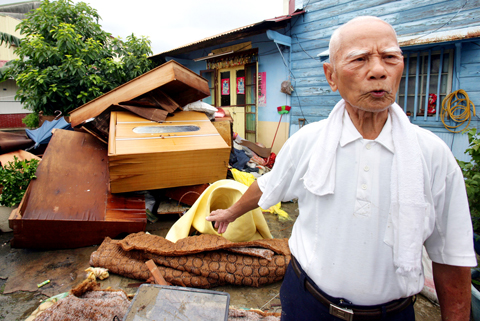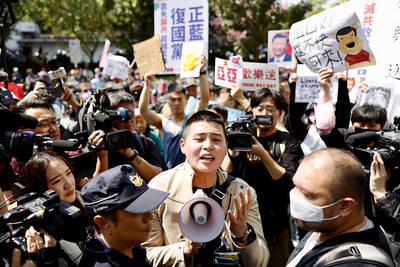Relief workers continued search and rescue operations yesterday after Tropical Storm Kalmaegi wreaked havoc in southern and central Taiwan the previous day.
Casualties from floods and mudslides were reported in the worst-hit areas in central and southern Taiwan, where up to 950mm of rain fell in less than two days, the National Fire Agency said.
Nearly 60,000 government and civilian rescuers have been mobilized to combat floods, conduct rescue missions and help clear thick mud that covered roads and filled residences, it said.

PHOTO: CNA
As of press time, the death toll was 18, with the latest casualty an elderly woman who was earlier reported to be missing after falling into a river while riding her motorcycle in Pingtung County yesterday morning, the National Disaster Response Center said.
Seven people, believed to have been washed away by floods or buried alive, remained missing, while eight others were injured, it said.
Kaohsiung County suffered the heaviest human toll nationwide, with eight fatalities, seven missing and five injured, followed by Tainan County with three fatalities and three injured.
The other two deaths occurred in Chiayi and Miaoli counties.
At least five low-lying areas in central and southern Taiwan were still inundated by floods brought by torrential rains, the center said.
Utilities in southern Taiwan have also been interrupted, with 12,994 households still without electricity and 268,473 homes without running water. The center expected power and water to be resorted by last night.
Kalmaegi also ravaged fields and farms. Council of Agriculture statistics showed losses reaching NT$581 million (US$19.1 million) as of 4pm yesterday, with the majority — or NT$445 million — coming from damage to crops.
By region, Yunlin County was the hardest hit, suffering losses totaling NT$101.82 million, making it eligible for subsidies and low-interest loans under the country’s disaster relief laws.
The second hardest-hit area was Tainan County, recording losses amounting to NT$94.97 million, followed by Kaohsiung County with NT$49.13 million, Nantou County with NT$45.25 million, Changhua County with NT$31.85 million and Taichung County with NT$28.64 million.
Chu Jin-shi (朱金錫), the council’s chief of farmers’ welfare, urged farmers who qualify for relief under the law to take advantage of the subsidies to get back on their feet.
The Environmental Protection Administration (EPA) yesterday urged the public to clean up flooded areas in their neighborhood to prevent the spread of diseases, including dengue fever.
“Environmental protection units formed emergency environmental disaster response centers across the country as soon as Kalmaegi struck on Friday,” said Yuan Shaw-ying (袁紹英), director-general of the EPA’s environmental sanitation and toxic substance management department.
“Cleaning and disinfecting work began nationwide yesterday,” he said.
Yuan said the EPA had ordered its subordinate units to finish the cleanup by tomorrow when people begin to go back to work or school.
Places that would collect puddles of water, such as flower pots or gutters, should be kept dry, Yuan said.
“Since the Aedes aegypti mosquito sometimes lays eggs on the outer rims of water containers, it is important to scrub the places you clean, in addition to pouring the water out,” he said.
President Ma Ying-jeou (馬英九), faced with the first major natural disaster since his May 20 inauguration, blamed the lack of preparedness for the storm on the Central Weather Bureau (CWB), which he said provided an inadequate warning.
In response, Daniel Wu (吳德榮), director of the CWB’s weather forecast center, told reporters that “a margin of error is inevitable” in weather forecasting.
The CWB yesterday urged residents in central and southern Taiwan to brace for further downpours although the storm was moving toward the Chinese province of Fujian.
If Kalmaegi had a silver lining after its torrential rains devastated central and southern Taiwan on Friday, it would be the abundant water it poured into local reservoirs to ensure a drought-free year.
The Water Resources Agency said that Tsengwen Reservoir (曾文水庫) in Tainan County — the largest reservoir in the country — collected 310 million tonnes of water within one day, increasing its level from 40 percent to 92.4 percent full.
The reservoir’s administration said it was prepared to open the dam’s floodgates yesterday if the reservoir continued to fill up.
Nanhua Reservoir (南化水庫), also in Tainan County, opened it sluice gates on Friday when it reached its maximum storage capacity of 141.84 million cubic meters.
Beihe Reservoir (白河水庫), which is mainly used for irrigation of the Tainan area, was filled to capacity on Thursday night and its administration officials immediately opened the floodgates.
Shihmen Reservoir (石門水庫) in Taoyuan County also began to adjust its water level around noon on Friday. As of press time, the water level had reached the 241m mark — only 4m below the maximum level — representing 83.63 percent of the reservoir’s storage capacity.

ENDEAVOR MANTA: The ship is programmed to automatically return to its designated home port and would self-destruct if seized by another party The Endeavor Manta, Taiwan’s first military-specification uncrewed surface vehicle (USV) tailor-made to operate in the Taiwan Strait in a bid to bolster the nation’s asymmetric combat capabilities made its first appearance at Kaohsiung’s Singda Harbor yesterday. Taking inspiration from Ukraine’s navy, which is using USVs to force Russia’s Black Sea fleet to take shelter within its own ports, CSBC Taiwan (台灣國際造船) established a research and development unit on USVs last year, CSBC chairman Huang Cheng-hung (黃正弘) said. With the exception of the satellite guidance system and the outboard motors — which were purchased from foreign companies that were not affiliated with Chinese-funded

PERMIT REVOKED: The influencer at a news conference said the National Immigration Agency was infringing on human rights and persecuting Chinese spouses Chinese influencer “Yaya in Taiwan” (亞亞在台灣) yesterday evening voluntarily left Taiwan, despite saying yesterday morning that she had “no intention” of leaving after her residence permit was revoked over her comments on Taiwan being “unified” with China by military force. The Ministry of the Interior yesterday had said that it could forcibly deport the influencer at midnight, but was considering taking a more flexible approach and beginning procedures this morning. The influencer, whose given name is Liu Zhenya (劉振亞), departed on a 8:45pm flight from Taipei International Airport (Songshan airport) to Fuzhou, China. Liu held a news conference at the airport at 7pm,

AIR SUPPORT: The Ministry of National Defense thanked the US for the delivery, adding that it was an indicator of the White House’s commitment to the Taiwan Relations Act Deputy Minister of National Defense Po Horng-huei (柏鴻輝) and Representative to the US Alexander Yui on Friday attended a delivery ceremony for the first of Taiwan’s long-awaited 66 F-16C/D Block 70 jets at a Lockheed Martin Corp factory in Greenville, South Carolina. “We are so proud to be the global home of the F-16 and to support Taiwan’s air defense capabilities,” US Representative William Timmons wrote on X, alongside a photograph of Taiwanese and US officials at the event. The F-16C/D Block 70 jets Taiwan ordered have the same capabilities as aircraft that had been upgraded to F-16Vs. The batch of Lockheed Martin

GRIDLOCK: The National Fire Agency’s Special Search and Rescue team is on standby to travel to the countries to help out with the rescue effort A powerful earthquake rocked Myanmar and neighboring Thailand yesterday, killing at least three people in Bangkok and burying dozens when a high-rise building under construction collapsed. Footage shared on social media from Myanmar’s second-largest city showed widespread destruction, raising fears that many were trapped under the rubble or killed. The magnitude 7.7 earthquake, with an epicenter near Mandalay in Myanmar, struck at midday and was followed by a strong magnitude 6.4 aftershock. The extent of death, injury and destruction — especially in Myanmar, which is embroiled in a civil war and where information is tightly controlled at the best of times —